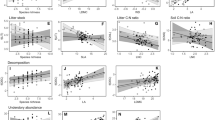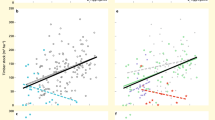Abstract
This chapter summarizes how plant species composition and richness in the Andean montane forests of southern Ecuador are driven by environmental heterogeneity. Natural vegetation dynamics of these highly diverse forests is dramatically affected by the current human land use practices with the consequence of an immense loss of species richness that most likely results in a drastic deterioration of ecosystem services on the landscape level. Basic knowledge about ecosystem functioning is still scarce for the region, and the study of plant functional traits should receive increasing attention, since these traits are the main attribute by which plants influence ecosystem functioning and thus ecosystem services.
Access this chapter
Tax calculation will be finalised at checkout
Purchases are for personal use only
Similar content being viewed by others
References
Balvanera P, Pfisterer AB, Buchmann N, He J-S, Nkashizuka T, Raffaelli D, Schmid B (2006) Quantifying the evidence for biodiversity effects on ecosystem functioning and services. Ecol Lett 9:1146–1156
Bush MB (2002) Distributional change and conservation on the Andean flank: a paleoecological perspective. Glob Ecol Biogeogr 11:463–473
Bussmann RW, Wilcke W, Richter M (2008) Landslides as important disturbance regimes – causes and regeneration. In: Beck E, Bendix J, Kottke I, Makeschin F, Mosandl R (eds) Gradients in a tropical mountain ecosystem of Ecuador, vol 198, Ecological studies. Springer, Berlin, pp 319–330
Cadotte MW, Carscadden K, Mirotchnick N (2011) Beyond species: functional diversity and the maintenance of ecological processes and services. J Appl Ecol 48:1079–1087
de Bello F, Lavorel S, Díaz S, Harrington R, Cornelissen JHC, Bardgett RD, Berg MP, Cirpriotti P, Feld CK, Hering D, Martins da Silva P, Potts SG, Sandin L, Sousa JP, Storkey J, Wardle DA, Harrison PA (2010) Towards an assessment of multiple ecosystem processes and services via functional traits. Biodivers Conserv 19:2873–2893
Diaz S, Lavorel S, de Bello F, Quetier F, Grigulis K, Robson TM (2007) Incorporating plant functional diversity effects in ecosystem service assessments. Proc Natl Acad Sci USA 104:20684–20689
Diertl K-HJ (2010) Pflanzendiversität entlang eines Höhengradienten in den Anden Südecuadors. Dissertation thesis, Universität Erlangen-Nuremberg, 277 p. (http://www.opus.ub.uni-erlangen.de/opus/volltexte/2011/2234/pdf/KARL_HEINZDIERTLDISSERTATION.PDF)
FAO (2005) State of the world’s forests 2005. Food and Agriculture Organization of the United Nations, Rome
Gascon C, Lovejoy TE, Bierregaard RO, Malcolm JR, Stouffer PC, Vasconcelos HL, Laurance WF, Zimmerman B, Tocher M, Borges S (1999) Matrix habitat and species richness in tropical forest remnants. Biol Conserv 91:223–229
Göttlicher D, Obregon A, Homeier J, Rollenbeck R, Nauss T, Bendix J (2009) Landcover classification in the Andes of southern Ecuador using ETM + and MODIS data as a basis for multi-scale SVAT modeling. Int J Remote Sens 30:1867–1886
Gove AD, Majer JC, Rico-Gray V (2009) Ant assemblages in isolated trees are more sensitive to species loss and replacement than their woodland counterparts. Basic Appl Ecol 10:185–197
Hietz P (2005) Conservation of vascular epiphyte diversity in a Mexican coffee plantation. Conserv Biol 19:391–399
Homeier J (2008) The influence of topography on forest structure and regeneration dynamics in an Ecuadorian montane forest. In: Gradstein SR, Homeier J, Gansert D (eds) The tropical mountain forest – patterns and processes in a biodiversity hotspot, vol 2, Biodiversity and ecology series. Göttingen Centre for Biodiversity and Ecology, Göttingen, pp 97–107
Homeier J, Breckle S-W (2008) Gap-dynamics in a tropical lower montane forest in South Ecuador. In: Beck E, Bendix J, Kottke I, Makeschin F, Mosandl R (eds) Gradients in a tropical mountain ecosystem of Ecuador, vol 198, Ecological studies. Springer, Berlin, pp 311–317
Homeier J, Werner FA (2007) Spermatophyta checklist Reserva Biológica San Francisco (Prov. Zamora-Chinchipe, S-Ecuador). In: Liede-Schumann S, Breckle S-W (eds) Provisional checklists of flora and fauna of the San Francisco valley and its surroundings, vol 4, Ecotropical Monographs. Estación Científica San Francisco, Southern Ecuador, pp 15–58
Homeier J, Werner FA, Gradstein SR, Breckle S-W, Richter M (2008) Potential vegetation and floristic composition of Andean forests in South Ecuador, with a focus on the RBSF. In: Beck E, Bendix J, Kottke I, Makeschin F, Mosandl R (eds) Gradients in a tropical mountain ecosystem of Ecuador, vol 198, Ecological studies. Springer, Berlin, pp 87–100
Homeier J, Breckle S-W, Günter S, Rollenbeck RT, Leuschner C (2010) Tree diversity, forest structure and productivity along altitudinal and topographical gradients in a species-rich Ecuadorian montane rainforest. Biotropica 42:140–148
Isbell F, Calcagno V, Hector A, Connolly J, Harpole WS, Reich PB, Scherer-Lorenzen M, Schmid B, Tilman D, van Ruijven J, Weigelt A, Wilsey BJ, Zavaleta ES, Loreau M (2011) High plant diversity is needed to maintain ecosystem services. Nature 477:199–203
Jost L (2006) Entropy and diversity. Oikos 113:363–375
Köster N, Friedrich K, Nieder N, Barthlott W (2009) Conservation of epiphyte diversity in an Andean landscape transformed by human land use. Conserv Biol 23:911–919
Larrea M, Werner FA (2010) Response of vascular epiphyte diversity to different land-use intensities in a neotropical montane wet forest. For Ecol Manage 260:1950–1955
Laurance WF (2004) Forest-climate interactions in fragmented tropical landscapes. Philos Trans R Soc Lond B Biol Sci 359:345–352
Liede-Schumann S, Breckle S-W (eds) (2007) Provisional Checklists of Flora and Fauna of the San Francisco valley and its surroundings, vol 4, Ecotropical Monographs. Estación Científica San Francisco, Prov. Zamora-Chinchipe, Southern Ecuador
Lyons KG, Brigham CA, Traut BH, Schwartz MW (2005) Rare species and ecosystem functioning. Conserv Biol 19:1019–1024
Mace GM, Norris K, Fitter AH (2012) Biodiversity and ecosystem services: a multilayered relationship. Trends Ecol Evol 27:19–26
Manning AD, Fischer J, Lindenmayer DB (2006) Scattered trees are keystone structures – Implications for conservation. Biol Conserv 132:311–321
Millenium Ecosystem Assessment (2005) Ecosystems and human well-being: biodiversity synthesis. World Resources Institute, Washington, DC
Mosandl R, Günter S, Stimm B, Weber M (2008) Ecuador suffers the highest deforestation rate in South America. In: Beck E, Bendix J, Kottke I, Makeschin F, Mosandl R (eds) Gradients in a tropical mountain ecosystem of Ecuador, vol 198, Ecological studies. Springer, Heidelberg, pp 37–40
Muenchow J, Brenning A, Richter M (2012) Geomorphic process rates of landslides along a humidity gradient in the tropical Andes. Geomorphology 139(140):271–284
Nöske N (2005) Effekte anthropogener Störung auf die Diversität kryptogamischer Epiphyten (Flechten, Moose) in einem Bergregenwald in Südecuador. Dissertation, Universität Göttingen, 137 pp
Nöske NM, Hilt N, Werner FA, Brehm G, Fiedler K, Sipman HJM, Gradstein SR (2008) Disturbance effects on epiphytes and moths in a montane forest in Ecuador. Basic Appl Ecol 9:4–12
Ohl C, Bussmann R (2004) Recolonisation of natural landslides in tropical mountain forests of Southern Ecuador. Feddes Repert 115:248–264
Peters T, Diertl K-H, Gawlik J, Rankl M, Richter M (2010) Vascular plant diversity in natural and anthropogenic ecosystems in the Andes of southern Ecuador. Mt Res Dev 30:344–352
Poltz K, Zotz G (2011) Vascular epiphytes on isolated pasture trees along a rainfall gradient in the lowlands of Panama. Biotropica 43:165–172
Portela R, Rademacher I (2001) A dynamic model of patterns of deforestation and their effect on the ability of the Brazilian Amazonia to provide ecosystem services. Ecol Modell 143:115–146
Restrepo C, Walker LR, Shiels AB, Bussmann R, Claessens L, Fisch S, Lozano P, Negi G, Paolini L, Poveda G, Ramos-Scharrón C, Richter M, Velázquez E (2009) Landsliding and its multiscale influence on mountainscapes. Bioscience 59:685–698
Roos K, Rollenbeck R, Peters T, Bendix J, Beck E (2010) Growth of tropical bracken (Pteridium arachnoideum): response to weather variations and burning. Invasive Plant Sci Manage 3:402–411
Takyu M, Aiba S-I, Kitayama K (2002) Effects of topography on tropical lower montane forests under different geological conditions on Mount Kinabalu, Borneo. Plant Ecol 159:35–49
TEEB (2009) TEEB climate issues update: the economics of ecosystems and biodiversity. September 2009
Webb EL, Stanfield BJ, Jensen ML (1999) Effects of topography on rainforest tree community structure and diversity in American Samoa, and implications for frugivore and nectarivore populations. J Biogeogr 26:887–897
Werner FA (2011) Reduced growth and survival of vascular epiphytes on isolated remnant trees in a recent tropical montane forest clear-cut. Basic Appl Ecol 12:172–181
Werner FA, Gradstein SR (2008) Seedling establishment of vascular epiphytes on isolated and enclosed forest trees in an Andean landscape, Ecuador. Biodivers Conserv 17:3195–3207
Werner FA, Gradstein SR (2009) Diversity of dry forest epiphytes along a gradient of human disturbance in the tropical Andes. J Veg Sci 20:59–68
Werner FA, Homeier J, Gradstein SR (2005) Diversity of vascular epiphytes on isolated remnant trees in the montane forest belt of southern Ecuador. Ecotropica 11:21–40
Werner FA, Köster N, Kessler M, Gradstein SR (2012) Is the resilience of epiphyte assemblages to human disturbance a function of local climate? Ecotropica 17:15–20
Wolf JHD (2005) The response of epiphytes to anthropogenic disturbance of pine-oak forests in the highlands of Chiapas, Mexico. For Ecol Manage 212:376–393
Wolf K, Veldkamp E, Homeier J, Martinson GO (2011) Nitrogen availability links forest productivity, soil nitrous oxide and nitric oxide fluxes of a tropical montane forest in southern Ecuador. Global Biogeochem Cycles 25, GB4009
Zahawi RA, Augspurger CK (2006) Tropical forest restoration: tree islands as recruitment foci in degraded lands of Honduras. Ecol Appl 16:464–478
Author information
Authors and Affiliations
Corresponding author
Editor information
Editors and Affiliations
Rights and permissions
Copyright information
© 2013 Springer-Verlag Berlin Heidelberg
About this chapter
Cite this chapter
Homeier, J., Werner, F.A., Gawlik, J., Peters, T., Diertl, KH.J., Richter, M. (2013). Plant Diversity and Its Relevance for the Provision of Ecosystem Services. In: Bendix, J., et al. Ecosystem Services, Biodiversity and Environmental Change in a Tropical Mountain Ecosystem of South Ecuador. Ecological Studies, vol 221. Springer, Berlin, Heidelberg. https://doi.org/10.1007/978-3-642-38137-9_8
Download citation
DOI: https://doi.org/10.1007/978-3-642-38137-9_8
Published:
Publisher Name: Springer, Berlin, Heidelberg
Print ISBN: 978-3-642-38136-2
Online ISBN: 978-3-642-38137-9
eBook Packages: Biomedical and Life SciencesBiomedical and Life Sciences (R0)




